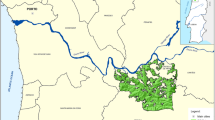Abstract
Advances in personal computers (PCs) have increased interest in computer-based road-design systems to provide rapid evaluation of alternative alignments. Optimization techniques can provide road managers with a powerful tool that searches for large numbers of alternative alignments in short spans of time. A forest road optimization model, integrated with two optimization techniques, was developed to help a forest road engineer in evaluating alternative alignments in a faster and more systematic manner. The model aims at designing a path with minimum total road costs, while conforming to design specifications, environmental requirements, and driver safety. To monitor the sediment production of the alternative alignments, the average sediment delivered to a stream from a road section was estimated by using a road erosion/delivery model. The results indicated that this model has the potential to initiate a new procedure that will improve the forest road-design process by employing the advanced hardware and software capabilities of PCs and modern optimization techniques.
Similar content being viewed by others
References
AASHTO 1990 American association of safe highway and transportation officials. A policy on geometric design of highways and streets, Washington, DC
Akay A 2004 A new methodology in designing forest roads.Turkish J. Agricul. Forest. 28: 273–279
Akay A, Sessions J 2005 Applying the decision support system, TRACER, to forest road design.Western J. Appl. For. 20: 184–191
Akay A, Yuksel A, Reis M, Erdas O, Sessions J 2005 Selecting the optimal forest road alignment with a maximum sediment production constraint.28th Annual Meeting of COFE (Council on Forest Engineering). Soil, Water and Timber Management: Forest Engineering Solutions in Response to Forest Regulation, California, USA, pp 302–311
Anderson A E, Nelson J D 2004 Projecting vector based road networks with a shortest path algorithm.Can. J. For. Res. 34: 1444–1457
Anderson J M, Mikhail E M, Woolnough D E 1985Introduction to surveying (New York: McGraw-Hill Ryerson)
Beasley J, Dowsland K, Glover F, Manue L, Peterson C, Reeves C, Soderberg B 1993Modern heuristic techniques for combinatorial problems (New York: Halsted, John Wiley & Sons)
Boise Cascade Corporation 1999 SEDMODL-Boise Cascade road erosion delivery model. Technical documentation, p. 19
Bowman E H, Fetter R B 1967Analysis for production and operations management (Irwin Series in Quantitative Analysis for Business) (New Haven, CT: Yale University Press.) p. 870
Burroughs E R, John G K 1989 Reduction of soil erosion on forest roads. Gen. Tech. Rep. INT-264. Ogden, UT: US Department of Agriculture, Forest Service, Intermountain Research Station, p. 21
Chew E P, Goh C J, Fwa T F 1989 Simultaneous optimization of horizontal and vertical alignment for highways.Transport. Res. B23: 315–329
Christian J, Newton L 1999 Highway construction and maintenance costs.Can. J. Civil Engg. 26: 445–452
Douglas R A 1999Delivery, the transportation of raw natural products from roadside to mill (New Brunswick, Canada: Fredericton)
Easa S M 1987 Earthwork allocations with linear unit costs.J. Constr. Eng. Manage. 114: 641–655
Easa S M 1988 Selection of roadway grades that minimize earthwork cost using linear programming.Transport. Res. A22: 121–136
Goh C J, Chew E P, Fwa T F 1988 Discrete and continuous models for computation of optimal vertical highway alignment.Transport. Res. B22: 399–409
Ichihara K, Tanaka T, Sawaguchi I, Umeda S, Toyokawa K 1996 The method for designing the profile of forest roads supported by genetic algorithm.J. Forest. Res. 1: 45–49
Kirkpatrick S, Gerlatt C D, Vecchi M P 1983 Optimization by simulated annealing,Science 220: 671–680
Klemperer D 1996 Forest resource economics and finance. Virginia Polytechnic Institute and State University, College of Forest and Wildlife Resources, Virginia, p. 551
Mannering F, Kilareski W 1990Principles of highway engineering and traffic analysis (New York: John Wiley & Sons) p. 251
Mayer R, Stark R 1981 Earthmoving logistics.J. Constr. Div. 107: 297–312
Reeves C 1993 Modern heuristic techniques for combinatorial problems. Department of Statistics and Operational Research School of Mathematical and Information Sciences, Coventry University, p. 320
Skaugset A, Marganne M A 1998 Forest road sediment and drainage monitoring project report for private and state lands in Western Oregon. Oregon Department of Forestry, Salem, OR, USA
Tan J 2000 Application of dynamic programming to optimum location of a forest road.Int. J. For. Eng. 11(2): 33–42
USDA Forest Service 1987 Road preconstruction handbook, Forest service handbook No. 7700.56
USDA Forest Service 1999 Cost estimate guide for road construction region 6. Cost Guide Zone 5, Davis-Bacon Area 5, Oregon
WDNR 1995 Standard methodology for conducting watershed analysis. Version 3.0. Washington Forest Practices Board
Author information
Authors and Affiliations
Rights and permissions
About this article
Cite this article
Akay, A.E. Minimizing total costs of forest roads with computer-aided design model. Sadhana 31, 621–633 (2006). https://doi.org/10.1007/BF02715918
Received:
Revised:
Issue Date:
DOI: https://doi.org/10.1007/BF02715918




